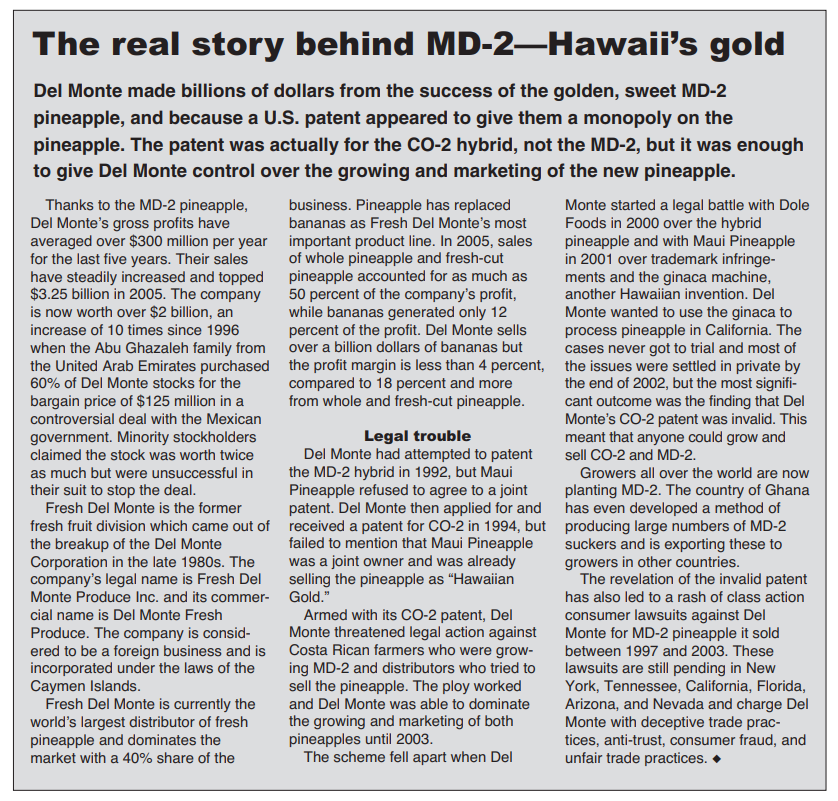Hawaii’s pineapple industry is not in trouble. There are challenges, but the two remaining pineapple growers, Dole Foods and Maui Pineapple Company, see a future for pineapple in Hawaii. In 2004, Dole reported profits of $257 million from sales of $3.54 billion in fresh fruit, most of which came from sales of banana and pineapple. Partial results for 2005 show that sales and profits for Dole will be slightly higher.
Maui Pineapple Company has been losing money, but some of that is due to a strategic decision to cut back on canned pineapple and focus on the more profitable fresh and organic market. The company lost income as they reduced canning, and there was the added expense of planting more of the Hawaiian Gold variety and changing planting schedules to produce pineapple year round. The company is banking on the future and is building a $17 million multi-purpose processing facility to replace its cannery and fresh fruit packing sheds.
American technology
Hawaii is still in the business of growing pineapple and can compete against low-wage foreign producers as long as it can keep the know-how and advanced pineapple technology in Hawaii. Much of the knowledge and technology to successfully grow pineapple as a commercial crop was developed and perfected in Hawaii. This technology enables Hawaii to produce 33,000 pounds of pineapple per acre, which is almost two times the world’s average of 17,000 pounds per acre.
The new golden sweet pineapple which is causing a spectacular growth in the worldwide consumption and sale of fresh pineapple was created by scientists in Hawaii. This pineapple is now grown all over the world, but each one is an exact copy or clone of plant #73-114, more commonly called MD-2. It was created in the laboratories of the Hawaii Pineapple Institute in 1973 by cross fertilizing hybrid clone #58- 1184 with pollen from hybrid clone #59-443. The Institute was trying to create the perfect pineapple—sweet, low in acid, yellow in color, resistance to disease, good fruit appearance after refrigeration, high yield, good fruit size. They succeeded with plant #73-114. Another seedling, #73-50 named CO-2, showed promise but was not as good as MD2.
The plants must then be raised outside of the laboratory in plantation conditions. It would take many more years of expensive research, experimentation, and trials before MD-2 was ready to grow on a commercial scale.
MD-2 was a very valuable discovery, but because the Hawaii Pineapple Institute was jointly funded by Dole, Del Monte, and Maui Pineapple, each company had access to its research. Del Monte began sending Hawaii grown MD-2 suckers and the technology to grow the new pineapple to its plantations in Costa Rica, where workers are paid between $1.00 and $1.50 an hour. By 1996, about 40% of Del Monte’s 21,000 acre Costa Rican plantation was planted with the new pineapple while 60% still produced the regular champaka variety.
Seeds from Hawaii
Del Monte began selling the new pineapple as Del Monte Gold in 1996. It was unlike any other pineapple on the market—it was low in acid, sweeter, and had a pleasing yellow color. It was an instant success and consumers couldn’t get enough of the fruit. In 1996, Del Monte sold 2.5 million boxes of fresh pineapple, and by 2005 the company was selling 20 million boxes at premium prices.
The strong demand for the new pineapple prompted Del Monte to convert all of its Costa Rican plantation to the new variety. The company also received $24 million from the Costa Rican government between 1997 and 1999 to pay for the conversion. The Costa Rican government was trying to expand the country’s export industries and may have been reassured by the fact that Marvin Bush, the brother of President George Bush and Florida Governor Jeb Bush, was on Fresh Del Monte’s board of directors.
The seeds for Costa Rica would come from Hawaii. For several years, all the best seed material from the Kunia plantation was flown to Costa Rica, leaving the less desirable stumps to propagate the Hawaii crop.
In 2003 Del Monte began planting MD-2 on 8,000 acres of company owned land in Brazil. In 2004, the company expanded to Africa to supply the European market and began planting 10,000 acres on leased land in Kenya. That same year, Del Monte cut its Hawaii acreage from 9,400 acres to 5,700.
Now that thousands of acres of pineapple in Kenya and Brazil are ready to harvest, Fresh Del Monte has no need for Hawaii.
In announcing the shutdown, Del Monte’s prepared statement said the reason was lower cost foreign pineapple. “As a result of increased planting of pineapple at lower costs in other parts of the world, the company believes that it will not be economically feasible to continue to produce pineapple in Hawai‘i.” Del Monte fails to mention most of this acreage is their own.
“In fact, today it would be cheaper for Del Monte to buy pineapples on the open market than for the company to grow, market and distribute Hawaiian pineapple.” Del Monte now sees Hawaii as just another source for its pineapple. The company neglected to acknowledge that Hawaii and the experience and know-how of Hawaii pineapple workers were the source of much of its fortune. ◆

